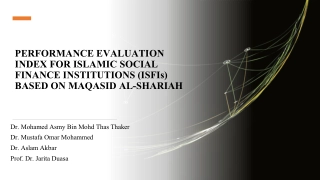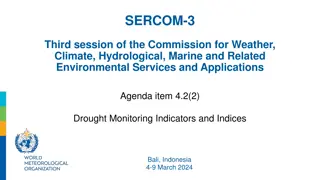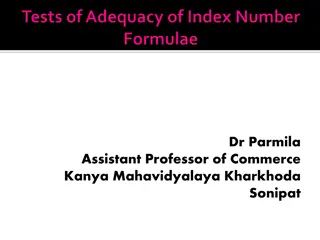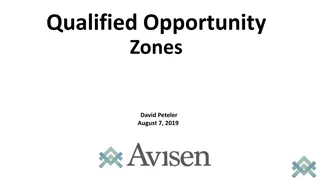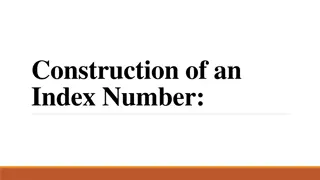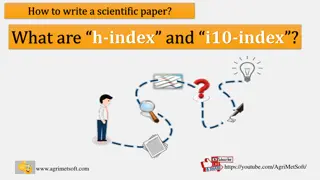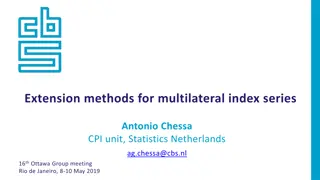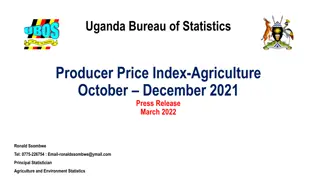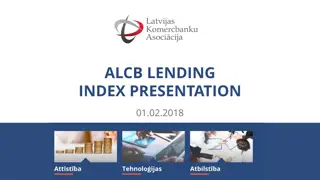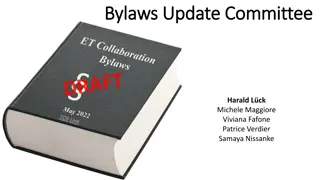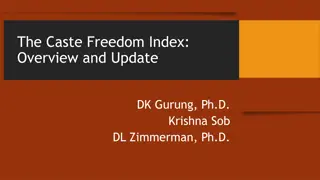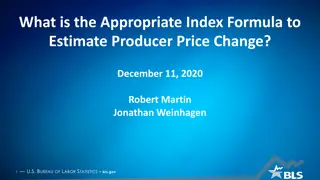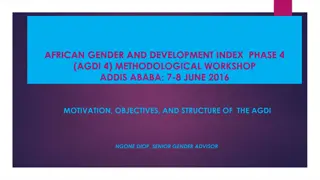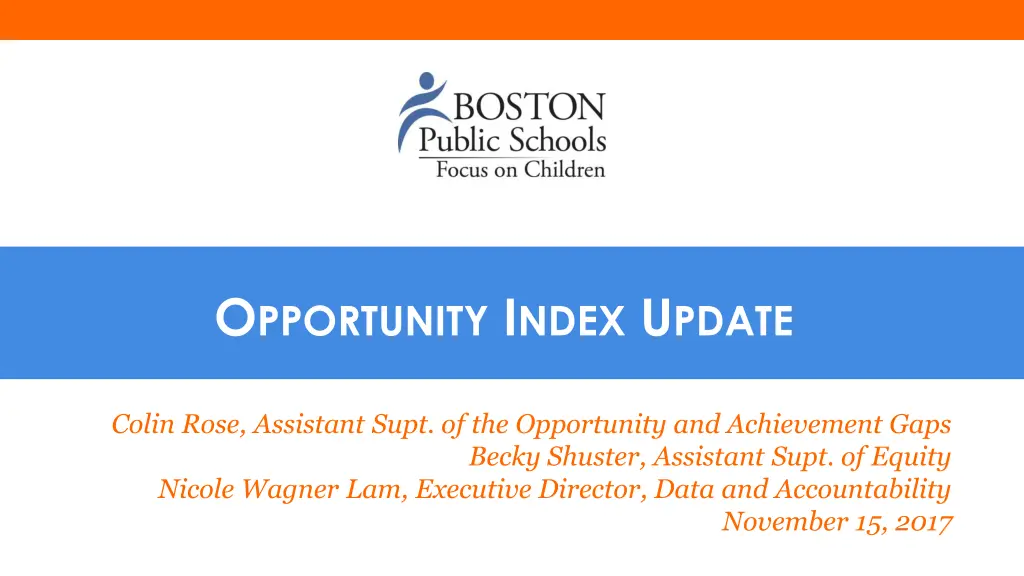
Boston Public Schools Opportunity Index Update - Achieving Equity in Education
"Discover how Boston Public Schools are implementing the Opportunity Index to bridge achievement gaps and provide targeted support for students in need. Learn about the purpose, calculation methods, and the importance of targeted universalism in education. Explore the commitment to equity and leveraging resources to empower students towards their full potential."
Download Presentation

Please find below an Image/Link to download the presentation.
The content on the website is provided AS IS for your information and personal use only. It may not be sold, licensed, or shared on other websites without obtaining consent from the author. If you encounter any issues during the download, it is possible that the publisher has removed the file from their server.
You are allowed to download the files provided on this website for personal or commercial use, subject to the condition that they are used lawfully. All files are the property of their respective owners.
The content on the website is provided AS IS for your information and personal use only. It may not be sold, licensed, or shared on other websites without obtaining consent from the author.
E N D
Presentation Transcript
BOSTON PUBLIC SCHOOLS OPPORTUNITY INDEX UPDATE Colin Rose, Assistant Supt. of the Opportunity and Achievement Gaps Becky Shuster, Assistant Supt. of Equity Nicole Wagner Lam, Executive Director, Data and Accountability November 15, 2017
BOSTON PUBLIC SCHOOLS BOSTON PUBLIC SCHOOLS School Committee 11/1/17 Opportunity Index Presentation Recap The Opportunity Index Policy: a proposal for district-wide application The purpose of the Index: implementing the Opportunity and Achievement Gap Policy How the Index is calculated: multiple individual- and neighborhood-based data points historically predictive of academic achievement, yielding a school-wide composite number 2
BOSTON PUBLIC SCHOOLS BOSTON PUBLIC SCHOOLS Contents Why do we need an Opportunity Index? What is an Opportunity Index? How do we ensure the right messaging? Who have we engaged for input? How might the Index be applied? 3
BOSTON PUBLIC SCHOOLS BOSTON PUBLIC SCHOOLS The Purpose of the Opportunity Index Schools have the power to transform young people s lives. To close opportunity and achievement gaps, the schools that are educating our highest need students must receive additional, targeted supports. This is at the heart of implementing the district s commitment to equity, leveraging resources to launch our students toward their full potential.
BOSTON PUBLIC SCHOOLS BOSTON PUBLIC SCHOOLS Targeted Universalism A targeted universal strategy is one that is inclusive of the needs of both the dominant and the marginal groups, but pays particular attention to the situation of the marginal group. Targeted universalism rejects a blanket universal, which is likely to be indifferent to the reality that different groups are situated differently relative to the institutions and resources of society. It also rejects the claim of formal equality that would treat all people the same as a way of denying difference. Any proposal would be evaluated by the outcome, not just the intent. John Powell, Post-Racialism or Targeted Universalism?, Denver University Law Review (2009) 5
BOSTON PUBLIC SCHOOLS BOSTON PUBLIC SCHOOLS Why do this? Our current tools follow national standards, but are relatively blunt in measuring student need 6
BOSTON PUBLIC SCHOOLS BOSTON PUBLIC SCHOOLS Contents Why do we need an Opportunity Index? What is an Opportunity Index? How do we ensure the right messaging? Who have we engaged for input? How might the Index be applied? 7
BOSTON PUBLIC SCHOOLS BOSTON PUBLIC SCHOOLS The Opportunity Index would measure variables outside of a school s control that impact student learning 1 Neighborhood Factors The collection of community and environmental factors that impact student learning 2 Student Specific Instructional Needs Academic needs, such as Special Education or English Language Learner status 3 Other Student and Family Information Individual student and family factors, such as poverty and previous academic outcomes 8
BOSTON PUBLIC SCHOOLS BOSTON PUBLIC SCHOOLS Developing the Opportunity Index: The Process Last year, we began exploring possible ways to better measure student need; our internal team drafted a preliminary Opportunity Index to understand how a tool like this might be calculated to more accurately identify schools in need of additional resources and supports to close opportunity and achievement gaps Over the last few months, a cross-functional BPS team worked with a locally focused research organization, the Boston Area Research Initiative (BARI), to build and improve upon the original concept, making it more nuanced and ensuring a high correlation with student achievement The BARI team conducted multilevel regression analysis on a number of neighborhood indicators and honed the list to five that are statistically significant to predict student achievement 9
BOSTON PUBLIC SCHOOLS BOSTON PUBLIC SCHOOLS What the Index is and how it is calculated The multilevel regression models used to generate the Index controlled for a number of the individual factors that BPS has data for, which we believe and know are predictive of future student academic outcomes (i.e. socio-economic status, special education status, english learning status, at-risk indicators, etc.) By controlling for these factors BARI was able to statistically isolate the contributions made by the factors found at the neighborhood level (i.e. adult academic attainment, public safety, neighborhood SES, physical disorder, and custodianship) and generate weights for each of these indicators that should be able to be extended beyond the Boston context The overall Index itself is, therefore, a combination of factors unique to individual students, as well as factors representing dynamics that are unique to their neighborhoods 10
BOSTON PUBLIC SCHOOLS BOSTON PUBLIC SCHOOLS How the Opportunity Index would vary based on student grade level and application The Opportunity Index is comprised of three building blocks: (1) neighborhood factors; (2) student-specific instructional needs; and (3) other student-specific information (such as poverty or previous academic outcomes). The second and third items, which are student-specific, are more predictive (and more available) as a student progresses through school. Therefore, as a student gets older, the composition of the index adjusts to reflect more student-specific information. BPS may draw differently on these building blocks depending on the situation. We will publish data for each of the building blocks as well as the overall composite Index, and always clearly indicate which data is being used and why. 11
BOSTON PUBLIC SCHOOLS BOSTON PUBLIC SCHOOLS Technical Detail: Draft Index Components Neighborhood factors -- detailed on the next page -- are found to be most impactful in elementary school By high school, most of the variation is explained by student demographics and past academic outcomes 12
BOSTON PUBLIC SCHOOLS BOSTON PUBLIC SCHOOLS Neighborhood weight; 5 categories & 10 indicators Neighborhood Categories Grades Included Indicator Data Source Definition Academic Attainment American Community Survey (ACS) All Grades Postsecondary attainment Percent of census tract adults who have earned a Bachelor s degree or higher Boston Area Research Initiative (BARI) Gun Use Rate of events that involve the use of guns (e.g. shooting) Neighborhood Safety All Grades Private Crime BARI Rate of events that reflect interpersonal conflict in the neighborhood (e.g. domestic violence) Public Crime BARI Rate of events that reflect interpersonal violence that do not involve a gun (e.g. fight) Family Poverty ACS Rate of poverty at the Census Tract level Median Household Income ACS Median household income of Census Tract Socioeconomic Status All Grades Public Assistance ACS Rate of receipt of SNAP benefits at the Census Tract Unemployment ACS Rate of unemployed individuals 16 years of age and older at the Census Tract Custodianship Elementary Custodianship BARI The likelihood that residents will use 311 to call in an issue in the public domain (e.g. pothole) The deterioration to and denigration of neighborhood structures and spaces, a combination of two measures from 311 reports regarding private neglect and public denigration Physical Disorder Elementary Physical Disorder BARI 13
BOSTON PUBLIC SCHOOLS BOSTON PUBLIC SCHOOLS Evaluating the Index Each year, we will recalculate the Index for schools to effectively account for student mobility (i.e. enrollment in and out of different schools and moving neighborhoods within Boston). Every 3 - 5 years, we will reevaluate the Index itself to confirm that indicators remain statistically significant, any shifts in weights are incorporated, and that new indicators are sufficiently explored. Within 1 - 3 years of beginning resource allocation based on the Index, we will evaluate the impact. We will gather qualitative feedback from stakeholders regarding implementation, and quantitative data regarding the impact of the policy decisions, holding all other things constant (such as instructional programming, effective teaching, and school quality). 14
BOSTON PUBLIC SCHOOLS BOSTON PUBLIC SCHOOLS Contents Why do we need an Opportunity Index? What is an Opportunity Index? How do we ensure the right messaging? Who have we engaged for input? How might the Index be applied? 15
BOSTON PUBLIC SCHOOLS BOSTON PUBLIC SCHOOLS The Opportunity Index is about addressing need, not labeling need The Opportunity Index acknowledges the realities of how racism, poverty, and other institutional and systemic inequities impact students lives These inequities are outside of students , families , or schools control, and have nothing to do with merit, potential, or effort The Opportunity Index is about addressing those realities by meeting needs because we know that every BPS student can flourish, and will when schools can meet their needs Opportunity Index data will be used in aggregate; individual student scores will not be shared with any audience 16
BOSTON PUBLIC SCHOOLS BOSTON PUBLIC SCHOOLS What can the Index tell us about Boston Neighborhoods? The Opportunity Index names some of the social dynamics currently present inside of Boston neighborhoods The relationship between most of these dynamics and future student outcomes is positive, highlighting the positive things going on in Boston neighborhoods rather than their deficits Additionally, neighborhood dynamics in Boston can change: the City and, more importantly, families in Boston neighborhoods have the power to change them Allocating greater resources and support to young people and schools based on the neighborhoods they live in is one way that City of Boston s school department can empower students and their families to change their neighborhoods 17
BOSTON PUBLIC SCHOOLS BOSTON PUBLIC SCHOOLS Contents Why do we need an Opportunity Index? What is an Opportunity Index? How do we ensure the right messaging? Who have we engaged for input? How might the Index be applied? 18
BOSTON PUBLIC SCHOOLS BOSTON PUBLIC SCHOOLS How we have engaged the community for input Time period Engagement efforts Summer of 2016 Two open sessions with school leaders Winter 2017 Multi-month, citywide engagement for Long Term Financial Planning; extensive feedback related to investing more in schools serving highest need students Spring 2017 Research of other district efforts Feedback sessions with leaders from other districts Spring through Fall of 2017 Budget Equity Working Group, monthly sessions to discuss investment priorities, including OI Fall 2017 Cross-functional working team engaged with BARI, providing input for their work and reacting to their output October 2017 School Leader Cabinet: Presentation of proposal and feedback Title I advisory group, including our largest partner organizations Working sessions with Instructional Superintendents (many former school leaders and current supervisors of school leaders) November 2017 40% of principals joined optional sessions to discuss OI proposal among other issues BSAC session with students Meeting scheduled with CPC, DELAC, and SpedPAC with an invitation to other parent groups (SPC) 19
BOSTON PUBLIC SCHOOLS BOSTON PUBLIC SCHOOLS Student Feedback When we describe each neighborhood, we need to make sure not to blame the residents, but instead understand the broken pieces of the system. Labeling neighborhoods is not problematic if the purpose is to identify and provide the resources they need. Students hope that the Opportunity Index will be used to drive resources to students who need them most, such as those experiencing transportation. challenges, food deserts, trauma, and displacement due to gentrification. The Index should be recalculated annually to account for population shifts (e.g. if a school had an influx in students from Puerto Rico the previous year, the Index number should change). *feedback was gathered from BSAC students during their weekly meeting held 11/6/17 20
BOSTON PUBLIC SCHOOLS BOSTON PUBLIC SCHOOLS School Leader Feedback School leaders appreciated this step toward equity and coherence. While individuals may be happy or unhappy with the impact on their school s resources, ultimately meeting students needs district-wide is the top priority. School leaders were thankful for the transparency in this process. If the Index is used to allocate resources, leaders want that information shared to coincide with the overall budget timeline, separate from probable org. School leaders wondered if the Index can accommodate nuances in their school populations, such as variances in the lower vs. upper grades. *feedback was gathered over two sessions with school leaders hosted 11/9/17 21
BOSTON PUBLIC SCHOOLS BOSTON PUBLIC SCHOOLS Family Feedback Parents included on the Partnership Portfolio Review committee have received an overview and responded positively Upcoming Meetings Joint meeting with the boards and membership of CPC, DELAC and SpedPAC (11/30) and invite all SPC and SSC parent reps Host a district-wide opportunity for other Boston parent groups including Phenomenal Moms, Mass Parents United, Project Right and CPLAN 22
BOSTON PUBLIC SCHOOLS BOSTON PUBLIC SCHOOLS Contents Why do we need an Opportunity Index? What is an Opportunity Index? How do we ensure the right messaging? Who have we engaged for input? How might the Index be applied? 23
BOSTON PUBLIC SCHOOLS BOSTON PUBLIC SCHOOLS Initial Application: School Partnership Funds Currently, $6.7M of partnership funding goes directly to a total of 14 external partners to serve BPS schools. We propose using the Opportunity Index to equitably reallocate the majority of these Partnership Funds directly to a subset of schools. (This will represent <1% of overall school funding.) This shift will empower schools -- as the unit of change -- to make their own partnership funding decisions based upon which partner(s) best meet the needs and priorities of their school community. Central office will provide schools with ongoing supports to make informed, data- driven partnership selections. For example, all schools will receive the Opportunity Portfolio: a menu of pre-vetted, high quality partner opportunities.
BOSTON PUBLIC SCHOOLS BOSTON PUBLIC SCHOOLS Potential Other Applications of the Index We will start small, listen, evaluate, and gradually grow the use of the Index Prioritizing sites for grant-funded Restorative Justice program Summer school program placement Exam School Initiative seats How the Index will not be used: We will not share any student-level Index scores We will not make adjustments to Weighted Student Funding in FY19 25
BOSTON PUBLIC SCHOOLS BOSTON PUBLIC SCHOOLS DRAFT: Opportunity Index Policy Statement The Boston Public Schools will formally adopt the Opportunity Index as a district-wide tool for making decisions that drive equity, coherence and innovation. Aligned with the School Committee s Opportunity and Achievement Gaps Policy, the Opportunity Index uses data from students home neighborhoods along with individual and family level data as a means for measuring opportunity gaps throughout the district. In turn, the Boston Public Schools will close these opportunity gaps by using the Index to make decisions, such as how we invest in communities, evaluate programs, and perform prospective and retrospective assessments. The Index will be updated annually to ensure the most predictive factors and recent information available are incorporated. 26

